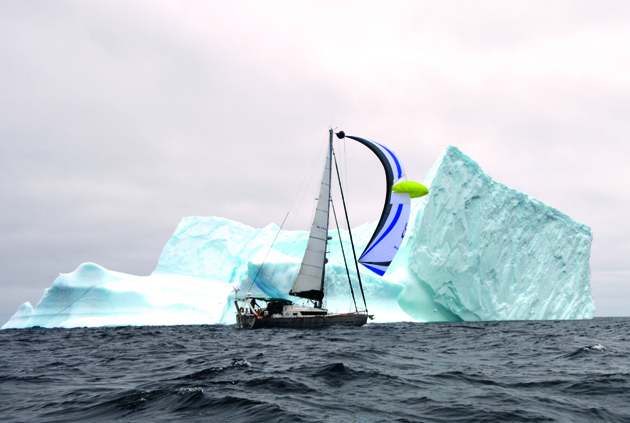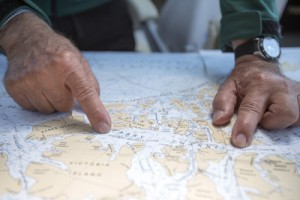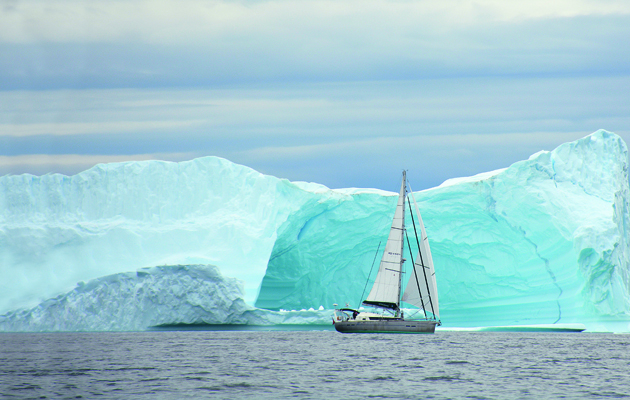Escape from the ice
But our luck held, and although it took us over eight hours to escape that icy maze, we eventually reached open water 27 miles from the point where the pack had first taken us captive.

Late that same evening we reached Point Barrow at the north-western extremity of Alaska and could finally turn east towards the North West Passage proper. At 71° 23’ N, there was nothing between us and the North Pole. Although we could see the dense ice pack close to the north of our course, there seemed to be a narrow gap along the Alaskan coast where the ice concentration was lower.
By staying in shallow water and sailing a parallel course to the coast, we could make headway at a reasonable pace, although every now and again we had to fight our way through a larger concentration of ice.
The drama of the previous day was soon forgotten as we motored and occasionally sailed through fields of ice, the floes reasonably spaced out to allow us to slalom between them. Being so far north we had 24 hours of daylight and we passed our time photographing the phantasmagoric shapes sculpted by sun and wind: a crowned Neptune on his throne, a pouncing crocodile, a brooding Mayan deity. It felt like walking through the gallery of a surrealist sculptor.
We continued making unexpectedly fast progress and as the ice started to thin out, we could relax and enjoy the beauty of the Arctic scenery.
As we crossed the demarcation line between the USA and Canada, Alaska and Yukon, the undulating snow-clad mountains were bathed in pastel colours by the midnight sun. It was a magic moment that lifted our spirits as we knew we had achieved the almost-impossible by having come so far long before the end of July.
Arrival in the high Arctic
We made our first Canadian landfall at Herschel Island and we could not have picked a better place of arrival in the High Arctic. Herschel Island has a rich and fascinating history and is rarely visited by boats like ours. Once a busy whaling station, the cluster of old buildings has been preserved as a capsule of times gone by and is now part of the Qikiqtaruk Territorial Park.
Just as the Arctic has been described as the canary in the mine for global weather, so Herschel is regarded as a symbol of the Arctic, as what happens in this microcosm of Arctic flora and fauna may point to the eventual consequences of climate changes in other environments.
There was a large group of scientists on Herschel Island involved in various research projects, from the depletion of the permafrost and resulting massive leaks of carbon dioxide into the atmosphere, to the greening of the Arctic and the possible effects of climate change on the endemic flora and fauna.
A German scientist, who had been monitoring conditions for several years, explained that on a much larger scale this could be the fate awaiting the vast Siberian tundra, where the accelerating instability of its permafrost would result in catastrophic consequences for the entire planet.
Migrating grizzly bear
The consequences of climate change were brought to our attention on the day of our arrival when a warden shot a large grizzly bear that had swum across from the mainland and posed a serious threat to the researchers roaming the island. He explained that grizzly bears were migrating into polar bear territory, and red foxes were displacing their Arctic cousins.
Having passed through the Western Arctic and its ice fields much earlier in the season than we had hoped, and with the ice situation still unfavourable in the east, we could slow down and turn the next stage of our voyage into a more leisurely cruise.
Our next stops were the Inuit settlements of Tuktoyaktuk and Ulukhaktok, typical of several urban centres that had been set up by the Canadian government to provide the native population with medical facilities, schools and airports.
We were warmly welcomed wherever we went as the people wanted to know what had brought us to those remote places. At Tuktoyaktuk, the mayor, Darral Nasogaluake, came to greet us. He then spoke at length about changes in their traditional way of life, now greatly influenced by the changing climate.

Mooring at Tuktoyaktuk
This was obviously a matter of serious concern among the Inuit as at our next stop, in Ulukhaktok, an old man explained that the place was so quiet because many families were at summer camps, hunting and fishing for winter supplies, but nowadays had to travel much farther than ever before.
He remarked that in recent years the seasons had been visibly changing and they were seeing fish, birds and even bats they had never seen before.
He could have added Aventura to that list too as he told us that he had not seen a sailing boat like ours for more years than the fingers of his hand.
Route ahead clear
It was time to move on as the ice charts showed that the route to Cambridge Bay was no longer barred so we rushed to get there. Because of its strategic location Cambridge Bay has been described as the ‘make or break’ point for anyone attempting a transit of the North West Passage.
For those like us coming from the west and chasing the retreating ice, this is the place to pass a nailbiting time waiting and hoping that the ice will break up in the Eastern Arctic to allow us to reach our goal: the Atlantic Ocean.
The settlement of Gjoa Haven is a place no sailor will miss as it was here that Roald Amundsen spent the first two winters of his successful transit of this challenging waterway. His Gjoa was the first vessel to achieve that aim and gave her name to this Inuit settlement.

Our welcome committee in Gjoa Haven
However, our enjoyable stopover in Gjoa Haven had to be cut short when the latest ice charts forecast an imminent improvement in the conditions ahead of us. With more than 300 miles to go to the point that would give us access to the Atlantic, we set off immediately.
This last section of the Passage proved to be the most difficult, as we had to contend with strong contrary winds as well as our route blocked by areas of heavy ice concentration. With the prospect of achieving our aim almost within reach, we spared no effort to make good progress and pushed on towards Bellot Strait and Peel Sound, the last obstacles on the way to Greenland and the Atlantic.

We timed our arrival at Bellot Strait carefully as the 17-mile-long strait is renowned for its fierce tidal currents and can only be negotiated on a favourable tide. Halfway through the strait we passed Zenith Point, which marks the northern extremity of continental America. Having sailed my former Aventura past Cape Horn, at the continent’s southern extremity, I now had reached its northernmost.
A few days later we crossed the Arctic Circle and, in the view of those who only consider a successful transit of the North West Passage as crossing this symbolic gateway both on the way north and south, we had achieved our aim.
Since we passed the Arctic Circle on the way north 34 days earlier, we had sailed 3,728 miles and, as number 87 to have made it through, we had made one of the fastest transits recorded by a sailing vessel.
Aventura for sale
Jimmy Cornell’s Exploration 45 built by Garcia Yachting is for sale. Since her launch in April 2014, Aventura has sailed over 24,000 miles. With no plans for any future long distance voyages, Jimmy Cornell has reluctantly decided to sell this boat that has come closest to his long sought-after ideal cruising yacht. Conceived by him as a boat for all seas and all seasons the Exploration 45 is proving to be a great success with 12 similar boats already built.
Built and equipped to Jimmy’s own specifications Aventura incorporates many non-standard features and is fitted with a wide range of safety, navigation and communications equipment. Fully equipped and in perfect condition, this tried and tested boat is ready to sail to anywhere in the world. Aventura is offered at €599,000 (ex-VAT).
Aventura is currently docked at Cherbourg in Western France. Anyone seriously interested should send an email to info@cornellsailing.com with “Aventura Sale” as the subject.

An accomplished sailor and author, in the last four decades Jimmy Cornell has sailed 200,000 miles, including three circumnavigations as well as voyages to Antarctica, Patagonia, Alaska and the Arctic. His book World Cruising Routes is one of the best-selling nautical publications in the world and since starting the ARC rally in the 1980s he has organised 24 transatlantic rallies, six round the world rallies and one round the world race. His Exploration 45, Aventura, was conceived as his ideal cruising boat. But he now says he might sell her in the next 12 months. See yachtingworld.com/yachts for more about her.




